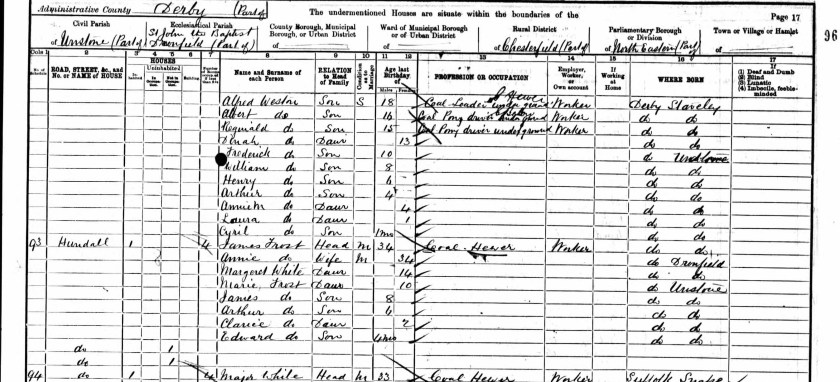James Frost was born in Unstone on 22 February 1893. His parents were James Frost and Annie (Wright) Frost, James was the third child for the couple. He attended St Mary’s School at Unstone and according to the Admission log he was living at Hundall. He transferred schools on 30th November 1900.

James would have been 7 years old when he was transferred, possibly to a Junior school.
By 1901 James had been joined by three younger siblings and the family were still living in Hundall.

Two more children were born Cyril 1904 and Clara in 1907.
There were sad times for the Frost family when Annie died in 1908 at the young age of 40, she was buried in Old Whittington churchyard on 22nd February, and James senior was left with small children to bring up on his own.
By 1911 the family had moved to Manor Terrace at Unstone Green and young James was now 18 years old and working, like his father, in the pit. James senior was a hewer and James junior was a loader. Prior to joining up James worked at Avenue pit Clay Cross.
The hewer is the actual coal-digger. Whether the seam be so thin that he can hardly creep into it on hands and knees, or whether it be thick enough for him to stand upright, he is the responsible workman who loosens the coal from the bed.
The loader was the man who loaded the coal into carts at the coal face.
In 1915 James married Annie Tyler and they had two children, Elizabeth born in 1916 and James born in December 1918. The family home was 348 Railway View Whittington Moor.
I am not exactly sure of the date that James joined up, his obituary seems to indicate he joined up in April 1918. His regimental number was 49665 and he joined the 6th Battalion the Leicester Regiment.
6th Battalion was attached to 110th brigade, 21st Division. The obituary would also suggest that James arrived in France on the 5th September 1918. His medal card would confirm that he did not serve overseas until after 31st December 1915.
James would arrive at the front at a time when the German army were starting to show weaknesses in strength and determination however, the British army had suffered heavy casualties already in 1918 and Sir Douglas Haig had decided to delay the allied advance for a short time.
On September 12th the Third army managed to take Havrincourt village from the Germans and this spurred Haig on to rethink his plans. The Battle of Epehy was to commence on September 18th and involve 21st Division, which included 6th Battalion Leicesters.
The war diary for the Battalion for the 5th – 18th September paints a picture of what James life in France would have been like.
5th September – Battalion in rest. Division relieved 38th Division.
6th September – Battalion marched by march route to Sailly Saillisel via Le Transloy. Brigade in reserve. Battalion bivouacked at NW end of village.
7th September – Battalion still in reserve moved by march route to wood 1500yds NW of Manancourt via Le Mesnil-en-Arrouaise. Battalion bivouacked.
8th September – 4am Battalion marched to Equancourt via Manancourt and Etricourt.
8th September – 9pm Marched to Heudecourt via Fins Brigade relieved 62nd Brigade 6th Leicester relieved 1st Lincolns in reserve.
9th and 10th September – The battalion were in close support to 64thBrigade.
11th September – Battalion in support. 7th Leicesters took the Yellow line. (this refers to the different colour lines on the trench map in this case the front line) Brigade relieved 64th Brigade.
12th September – 9pm Relieved the 7th Leicesters in the left sub sector of the front line.
13th September – 10am Enemy attack. A deserter warned us of this barrage prevented attack developing on the Battalion front. Enemy attacked 1st Wiltshire regiment on our left with Flammenwerfer (German Flamethrower operated by one man) but was driven off.
14th September – In left front sub sector.
15th September – Relieved by 1st Queens regiment, 33rd Division at night. Battalion moved back to camp 800yds east of Manancourt.
16th September – In camp east of Manancourt. Camp shelled in the afternoon. 4 casualties.
17th September – 8.30pm Moved off to assembly positions in yellow line via Equancourt, Sorel-le-Grand, Heudecourt.
18th September – 6.20am. Zero. Battalion attacked in conjunction with troops either side.
Thus commenced the Battle of Epehy. The Battle was a British success the Germans were forced back three miles, but not without cost.
James died from his wounds on 18th September 1918, he was 25 years of age. I have no definite confirmation he was wounded at Epehy, however his Battalion took part in the action and I am assuming James was involved. He would have been taken to a Casualty clearing station near to Beaulencourt (of which there were three) and was later buried in Thilloy Road Cemetery Beaulencourt.

Thilloy Road cemetery (ww1cemeteries.com)
More information on Thilloy Road cemetery can be found at
James died leaving a young widow and two children, his son James born in December 1918 would never meet his father!
He was awarded the British War and the Victory Medals.

James is remembered on the Brushes War memorial at Old Whittington and his death is recorded in the Leicester Regiment database at

James Frost obituary Derbyshire Times 28th September 1918.


